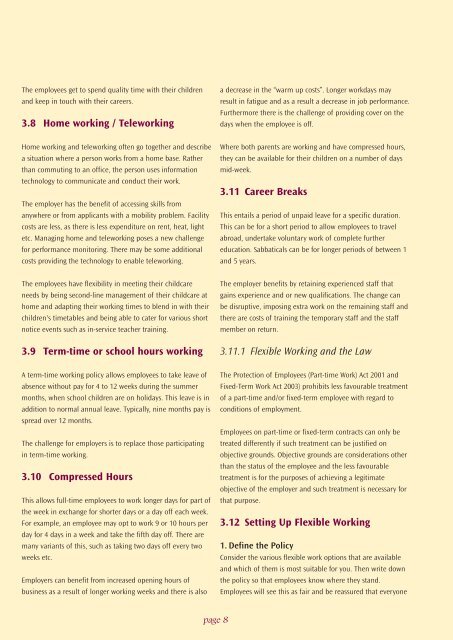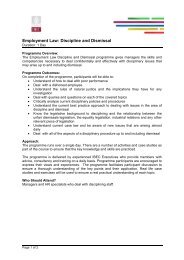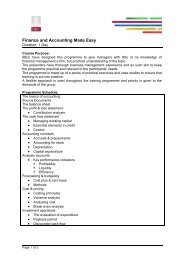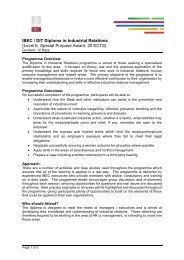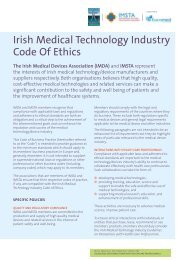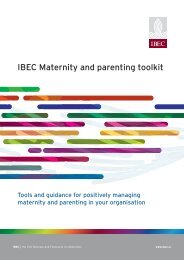Image Border - Irish Business and employers confederation
Image Border - Irish Business and employers confederation
Image Border - Irish Business and employers confederation
You also want an ePaper? Increase the reach of your titles
YUMPU automatically turns print PDFs into web optimized ePapers that Google loves.
The employees get to spend quality time with their children<br />
<strong>and</strong> keep in touch with their careers.<br />
3.8 Home working / Teleworking<br />
a decrease in the “warm up costs”. Longer workdays may<br />
result in fatigue <strong>and</strong> as a result a decrease in job performance.<br />
Furthermore there is the challenge of providing cover on the<br />
days when the employee is off.<br />
Home working <strong>and</strong> teleworking often go together <strong>and</strong> describe<br />
a situation where a person works from a home base. Rather<br />
than commuting to an office, the person uses information<br />
technology to communicate <strong>and</strong> conduct their work.<br />
The employer has the benefit of accessing skills from<br />
anywhere or from applicants with a mobility problem. Facility<br />
costs are less, as there is less expenditure on rent, heat, light<br />
etc. Managing home <strong>and</strong> teleworking poses a new challenge<br />
for performance monitoring. There may be some additional<br />
costs providing the technology to enable teleworking.<br />
Where both parents are working <strong>and</strong> have compressed hours,<br />
they can be available for their children on a number of days<br />
mid-week.<br />
3.11 Career Breaks<br />
This entails a period of unpaid leave for a specific duration.<br />
This can be for a short period to allow employees to travel<br />
abroad, undertake voluntary work of complete further<br />
education. Sabbaticals can be for longer periods of between 1<br />
<strong>and</strong> 5 years.<br />
The employees have flexibility in meeting their childcare<br />
needs by being second-line management of their childcare at<br />
home <strong>and</strong> adapting their working times to blend in with their<br />
children's timetables <strong>and</strong> being able to cater for various short<br />
notice events such as in-service teacher training.<br />
3.9 Term-time or school hours working<br />
The employer benefits by retaining experienced staff that<br />
gains experience <strong>and</strong> or new qualifications. The change can<br />
be disruptive, imposing extra work on the remaining staff <strong>and</strong><br />
there are costs of training the temporary staff <strong>and</strong> the staff<br />
member on return.<br />
3.11.1 Flexible Working <strong>and</strong> the Law<br />
A term-time working policy allows employees to take leave of<br />
absence without pay for 4 to 12 weeks during the summer<br />
months, when school children are on holidays. This leave is in<br />
addition to normal annual leave. Typically, nine months pay is<br />
spread over 12 months.<br />
The challenge for <strong>employers</strong> is to replace those participating<br />
in term-time working.<br />
3.10 Compressed Hours<br />
This allows full-time employees to work longer days for part of<br />
the week in exchange for shorter days or a day off each week.<br />
For example, an employee may opt to work 9 or 10 hours per<br />
day for 4 days in a week <strong>and</strong> take the fifth day off. There are<br />
many variants of this, such as taking two days off every two<br />
weeks etc.<br />
Employers can benefit from increased opening hours of<br />
business as a result of longer working weeks <strong>and</strong> there is also<br />
The Protection of Employees (Part-time Work) Act 2001 <strong>and</strong><br />
Fixed-Term Work Act 2003) prohibits less favourable treatment<br />
of a part-time <strong>and</strong>/or fixed-term employee with regard to<br />
conditions of employment.<br />
Employees on part-time or fixed-term contracts can only be<br />
treated differently if such treatment can be justified on<br />
objective grounds. Objective grounds are considerations other<br />
than the status of the employee <strong>and</strong> the less favourable<br />
treatment is for the purposes of achieving a legitimate<br />
objective of the employer <strong>and</strong> such treatment is necessary for<br />
that purpose.<br />
3.12 Setting Up Flexible Working<br />
1. Define the Policy<br />
Consider the various flexible work options that are available<br />
<strong>and</strong> which of them is most suitable for you. Then write down<br />
the policy so that employees know where they st<strong>and</strong>.<br />
Employees will see this as fair <strong>and</strong> be reassured that everyone<br />
page 8


